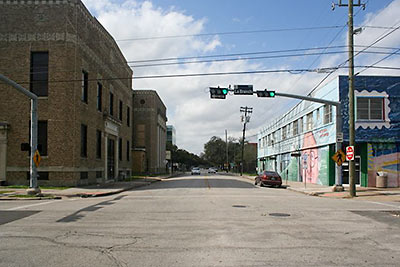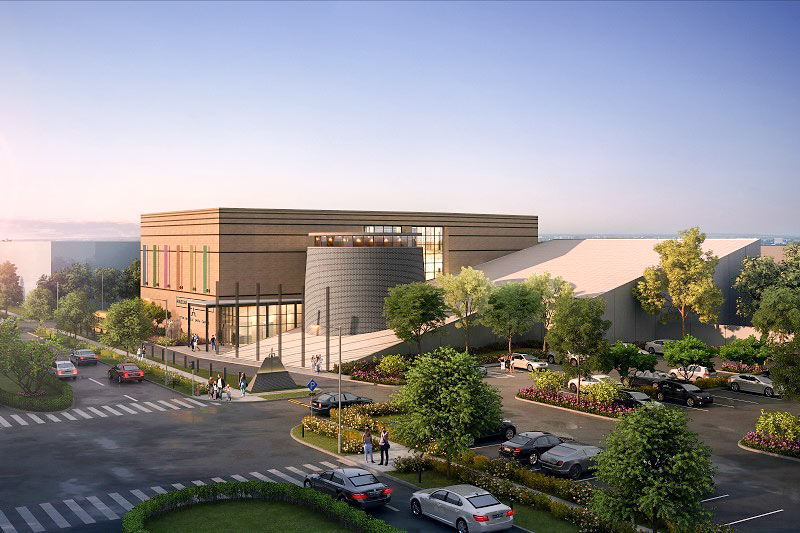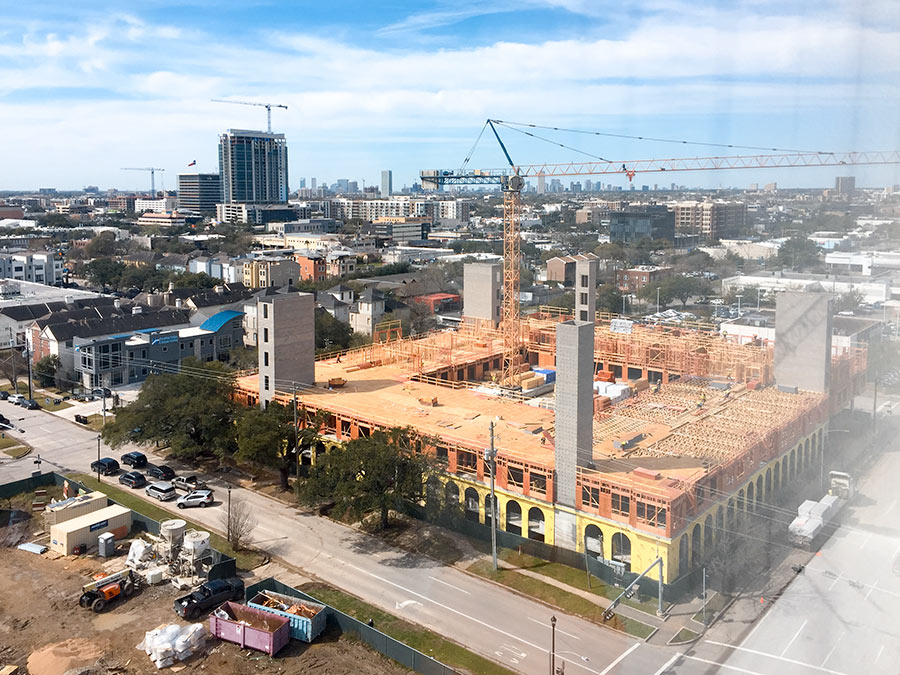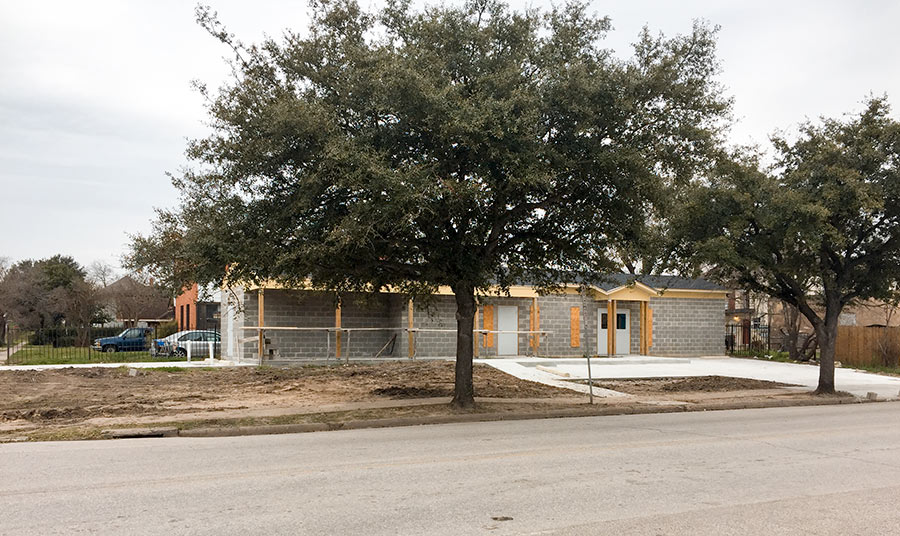
Urban-design nerds, street-festival fans, and earnest neighborhood do-gooders will converge on a block of Holman St. near LaBranch this Saturday to play a little game of make-believe: They’ll be imagining what it might be like if Houston had some sort of street life. From 10 am to 10 pm, they’ll be hanging out on a Third Ward Midtown block quickly made up to look as if it did: with painted-in bike lanes, instant street trees in planters, a pop-up cafe in a portable building parked on the street, food trucks, and maybe even a farmers’ market. And they’ll be smiling pedestrian-friendly smiles.
***
How will the resulting activity on the edge of the HCC central campus be any different from, say, the annual Midtown Art on the Park festival going on at the same time at nearby Baldwin Park? The “Hot Block on Holman” will be set up on actual streets and sidewalks, see, not on silly grass or park walkways. Plus it’ll stay open 4 hours later, to simulate actual non-valet-dependent street nightlife. The Holman project is a fully permitted and city-sanctioned version of a guerrilla event staged on North Tyler St. in Dallas’s Oak Cliff neighborhood last year that ended up spurring a wider do-it-yourself “Better Block” movement. It and a few follow-on demonstrations set a lot of wheels in motion in that city to get laws preventing that kind of street life reversed, and make it possible for some of the temporary changes there to become permanent. In the last year, similar events have been staged in Fort Worth; Oyster Bay, Long Island; Memphis, and Waco. Houston: You’re next!
A video chronicling the first event, in Dallas last year:
- Residents get street smart [Houston Chronicle]
- Hot Block on Holman [Better Block Houston]
- How to Build a Better Block [Better Block]
Photo of Holman St. at La Branch: Better Block Houston





Looking forward to the experiment. Anything to get people interacting outside of a car in this town should be a plus.
How cool! I plan to go – this is the first I’ve heard of it. Thanks for the heads up, Swamplot!
There was an actual coffee shop and art studio in the building on the right in the early 00s.
And who can forget the fun at the old collective artists commune near Elizabeth Baldwin Park?
Good REAL fun before the yuppie tear down.
Have fun with this fauxborhood.
FYI – Baldwin Park is for lazy people; How hard is it to say Elizabeth?
Sweet. 2 blocks from home. I can finally walk to something.
I think I’ll drive on over.
heightsite: Totally agree. If more people took advantage (or wanted) walkable neighborhoods we’d have more of them. Even Montrose, which I love, could use a bit less car reliance.
Make sure to come over to Art in the Park as well. I usually pick something up every year, and this year there will be rock and acoustic bands and other performances the entire day. They will also have painting classes this year where you drink wine and learn how to paint!
thank god! it’s about time. this is exactly why i drive all the way to the New Orleans French Quarter. will be great to have a place to actually get out of the vehicle and mingle on the street. now if we can keep the drive by shooters away. LOL
For as long as the Southwest Freeway has existed, this has been Midtown, not the Third Ward. The Third Ward is east of 59.
Third Ward starts at Main and goes East. Yes, the traditional heart is near Dowling, but the official map starts at Main.
Just off of the Lone Star Round Up in Austin (thank you Bob Schultz of Continental Club!)
and sighing…why does have to be this way? I love my hometown and have literally spent the last 2 decades of my life helping to create a residential base in Downtown and Midtown…only to watch the RISE and fall after the light rail/fiber optic mess that we have never come back from.
I watched hundreds and hundreds of people walking, biking, dining, drinking of course, dressed up, dressed down, with dogs, with kids, older, younger in Downtown Austin from the W to the Parkside to Jo’s down on SCO. There are electric car charging spots at the Whole Foods, not just at City Hall.
It makes me angry and sad at the same time.
Bring it on, Better Block! We need your vibe!
Mayor? Laura Sustainability Director?
You need Community to get through the budget cuts.
“fauxborhood”
How is this project different than any new home with “faux” Tuscan or Victorian exterior? Both are illusions. Just because the right group agrees with this project makes it better? How fickle and childish.
P.S. Look for people to instead of debate my point to just insult it.
kjb, Are you being serious?
You don’t know the difference between a house dressed-up to look like a castle, which only changes peoples’ pretensions, and trees in planters blocking a lane of a street, which actually slows down traffic, or cafes put out on sidewalks, which actually allow people to sit out on the street and have some food and meet other people?
This should be simple for you: One of these things affects people’s self-image only (faux Tuscan), and the other actually affects people’s behavior and actions (this). Sure the street stuff is temporary, but the things they do are real.
Andrew,
I am being serious. The reality is that no one would be utilizing this space in this way naturally. It has to be force to happen which is the problem.
Rice Village is an example of it happening naturally and staying there. Downtown and all the improvements to it is an example of forcing it and it still doesn’t happen.
Apparently during World War II, there was an airbase in New Guinea or on some nearby island. Allied planes would land and take off. They brought boxes of food and supplies which were shared with the local tribesmen, who had previously had very little interaction with the modern world. After the war, the allies packed up and left. The tribesmen, distressed, tried to recreate the landing field’s features–its windsock, its radio tower, etc.–in a mistaken notion that it was these physical manifestations that caused the planes filled with food and useful items to land. This is the origin of the term “cargo cult.” This simulacrum of a walkable neighborhood on Holman could be seen as an example of cargo cult thinking.
But to argue the other side, there is the famous example of the Brazil’s virtual currency, the unit of real value (unidade real de valor, or URV), a “fake” currency introduced in 1984 to tame Brazil’s long-time intractable hyper-inflation problem. The problem with hyper-inflation is similar to the problem with bubbles–it is as psychological as it is fiscal. In the case of Brazil, people had been living with hyper-inflation for so long that they acted as if the currency was inflating even when it wasn’t–so they would export it (by exchanging it for dollars), they would spend it right away, they would not keep it in banks, and many other actions that while they make sense on an individual level, perpetuate hyperinflation on a national level. The URV was a virtual currency that Brazilians were told was how the government was accounting for their money. The URV was pegged to the dollar. So when you got your paycheck, it would be in URVs–but also in Cruzeiros, the old (hyper-inflationary) currency. The idea behind the URV was to get the Brazilian people used to the idea of a non-inflating currency before introducing the actual new currency, the Real. And amazingly, it worked. The pretend currency, the URV, sort of showed Brazilians how a normal currency would function. While the Brazilian economy has had its hiccups, the Real has been a smashing success.
In short, this kind of simulacrum can be a delusional fantasy (as with the cargo cults) or it can be a way of training people for the real thing (as with the URV). I hope the Holman Street experiment is the latter. In any case, I don’t think anyone is going in with big illusions about how much this one-day event might change things.
(Sorry for being so verbose. This is a subject that is very interesting to me!)
kjb, Naturally? You think any architecture or engineering or development happens “naturally”? Beaver dams, maybe. Strip malls or pedestrian environments, not so much. It’s all artificial. The question is, to what effect.
Andrew, people often believe that outcomes they favor occur “naturally.”
Great info, Robert. And very interesting. It’d be great if Houston was more walking/biking friendly, anything that may help increase that is a step in the right direction.
@eiioi @Ross: The Main St. boundary is historically correct, but Swamplot has been using the more popular 59/288 boundary for all of its short history, so we should probably stick to it.
Speaking of Rice Village… It’s a parking nightmare, during busy times there’s absolutely nowhere to park and businesses police their assigned spots like Gestapo. At Istanbul grill people have to double and triple park. Point being you HAVE to accommodate cars to make a place convenient for customers, all the “walkable utopia” people seem to miss the point that you have to GET TO the area in a CAR to walk.
Whenever I go to rice, I go directly to that ‘roof top’ parking area. It’s free and I get a spot in 2 seconds. I don’t know why people circle around in the mall area street level parking.
.
And the point about a ‘walkable neighborhood’ is that people (should) have neighborhoods that are designed to be “LIVED” in. i.e., live where you can also walk around to shopping, eating, and fun — not just “live” as in a giant block of housing. Or said another way, the 100% opposite of suburbia.
.
They’re not trying to show you a cool place to DRIVE TO, they’re showing a cool place to LIVE AT so you don’t need to drive around that often.
If there are available spots in Rice Village but you have to know the secret passages and proper moon and venus alignment to find them, it doesn’t count.
.
Lets take the West Gray/Bagby intersection as an example of Livable/Walkable neighborhood. Heavy traffic, noise till 2 am from all the bars/restaurants, fight people for parking when you get home. The Randall’s is not exactly in walking distance if you have to carry more than a box of crackers. NO THANK YOU!!!
Thanks for posting, Robert Boyd – that was a very interesting read.